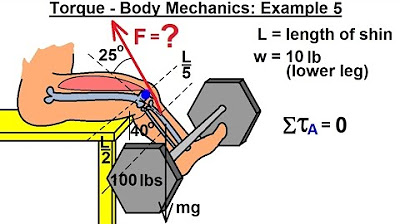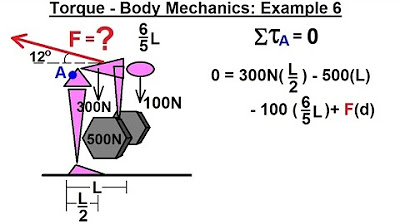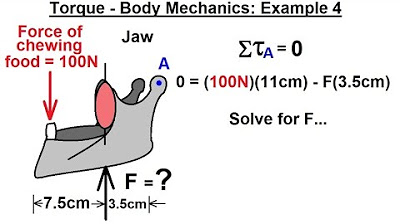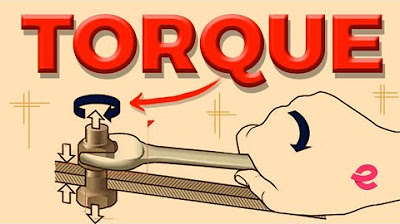Physics 15 Torque Example 5 (5 of 7) The Bicep
TLDRThe video script presents a fascinating exploration of torque problems as they relate to the human body, specifically focusing on the bicep muscle. It explains how the bicep functions in lifting a barbell, taking into account the muscle's attachment points and the leverage effect. The presenter uses the example of lifting a 40-pound barbell to illustrate the concept of torque, which is the force required to produce rotation around a pivot point—in this case, the elbow joint. By calculating the force exerted by the bicep, the video reveals that lifting the barbell requires a surprising 363 pounds of force from the bicep, demonstrating the remarkable strength of human muscles. The script is an engaging and informative look into the physics of everyday human movements.
Takeaways
- 💡 The biceps muscle plays a crucial role in lifting the arm and is connected to the humerus and forearm bone at different distances from the elbow joint.
- 🏋️♂️ When lifting a weight, such as a barbell, the bicep muscle has to work harder to overcome the force of gravity and the weight of the forearm itself.
- 📐 The problem presented is a torque problem, which involves calculating the force required by the bicep to lift a barbell by considering the distances and weights involved.
- ⚖️ The sum of all torques about the pivot point (the elbow joint) must equal zero, which is a fundamental principle in statics.
- 🔢 The force exerted by the bicep is calculated using the formula that takes into account the weight of the barbell, the weight of the forearm, and the distances from the pivot point to the points of force application.
- 🤔 The angle between the bicep's pull and the line of action is ignored due to its small size, simplifying the calculation.
- 📏 The distances used in the calculation are critical, with the forearm's center of mass assumed to be at the halfway point between the hand and the elbow joint.
- 🏋️♀️ The force required by the bicep to lift a 40-pound barbell is found to be 363 pounds, which is significantly higher than the actual weight being lifted.
- 😮 This result highlights that our muscles, particularly the bicep, are much stronger than we might initially perceive.
- 🧮 The units used in the calculation (pounds and centimeters) are mixed but will cancel out, leaving the final answer in pounds, which is the unit for force.
- 📉 The weight of the forearm and the barbell both contribute to the positive torque, while the bicep's force contributes to the negative torque, as it acts in the opposite direction.
- 🔍 The example demonstrates the application of physics principles to understand the mechanics of human movement and the forces involved in everyday activities.
Q & A
What is the primary focus of the example provided in the script?
-The primary focus is to demonstrate how to calculate the force required on the bicep when lifting a barbell using torque problems related to the human body.
What is the role of the bicep muscle in lifting a weight?
-The bicep muscle is responsible for lifting the arm up against gravity when a weight is held in the hand, such as during a barbell exercise.
What are the three forces considered in the torque problem?
-The three forces considered are the weight of the barbell (big mg), the weight of the forearm (little mg), and the force exerted by the bicep muscle.
What is the significance of the pivot point in the torque problem?
-The pivot point, in this case the elbow joint, is the point around which the torques are calculated. It is the reference point from which the perpendicular distances to the lines of action of the forces are measured.
Why is the angle between the bicep and the forearm ignored in the calculation?
-The angle is ignored because it is almost straight up, making it small and not significantly affecting the calculation of the force required by the bicep.
What units are used in the calculation and how are they handled?
-Pounds and centimeters are used in the calculation. The units of centimeters cancel out when dividing by the distance (d3), leaving the unit for force in pounds.
What is the calculated force on the bicep when lifting a 40-pound barbell?
-The calculated force on the bicep is 363 pounds, which is significantly more than the actual weight of the barbell being lifted.
What is the assumption made about the center of mass of the forearm?
-The assumption is that the center of mass of the forearm is at the halfway point between the middle of the hand (palm) and the elbow joint.
How does the distance from the elbow joint to where the barbell is held affect the force on the bicep?
-The distance (d1) affects the force on the bicep as it is part of the calculation for the torque caused by the weight of the barbell.
What is the role of gravity in this scenario?
-Gravity aids in bringing the arm back down after it has been lifted by the bicep, but it does not contribute to the lifting action itself.
Why is the force exerted by the bicep higher than the weight of the barbell?
-The force exerted by the bicep is higher because it has to overcome the torque created by the weight of the barbell and the weight of the forearm, in addition to lifting the barbell itself.
What does this example illustrate about the strength of human muscles?
-This example illustrates that human muscles, such as the bicep, are much stronger than one might think, as they can exert a force significantly greater than the weight they are lifting.
Outlines
💪 Understanding Bicep Torque in Lifting Weights
The first paragraph introduces the concept of torque problems related to the human body, specifically focusing on the bicep muscle. It explains how the bicep's position relative to the elbow joint creates leverage, which requires the bicep to exert significant force when lifting weights. The paragraph outlines a mathematical problem to calculate the force exerted by the bicep when lifting a 40-pound barbell, taking into account the weight of the forearm, the distance from the elbow joint to the point where the barbell is held, and the center of mass of the forearm. The problem is set up using torque principles, where the sum of all torques around the elbow joint equals zero, and the forces considered include the weight of the barbell, the weight of the forearm, and the force exerted by the bicep. The paragraph concludes by emphasizing the surprising strength of the bicep in performing this task.
📐 Calculating the Actual Force on the Bicep
The second paragraph continues the discussion on torque and force, providing a solution to the problem introduced in the first paragraph. It explains the process of calculating the force required by the bicep to lift a 40-pound barbell, including the conversion of units from pounds to the force's unit. The paragraph walks through the calculation, factoring in the distances from the pivot point (elbow joint) to the points of force application (barbell and forearm's center of mass) and the attachment point of the bicep. The final calculation reveals that the bicep must exert a force of 363 pounds to lift the barbell, which is significantly higher than the actual weight being lifted, underscoring the strength of the human musculature. The paragraph concludes by inviting the reader to contemplate the surprising strength of their muscles.
Mindmap
Keywords
💡Torque
💡Biceps
💡Barbell
💡Elbow Joint
💡Torque Problem
💡Pivot Point
💡Distance (d1, d2, d3)
💡Center of Mass
💡Weight
💡Force
💡Counterclockwise and Clockwise
Highlights
Explains how to use torque problems to analyze the force required on the bicep when lifting a barbell
Provides a detailed example using the biceps, forearm, and upper arm of a person
Describes the anatomy of the bicep and its attachment points to the humerus and forearm bone
Calculates the force the bicep needs to exert to lift a 40 pound barbell using torque equations
Assumes the forearm weighs 3 pounds and the distance from the elbow joint to the barbell is 35 cm
Uses the center of mass of the forearm as the halfway point between the hand and elbow joint
Sets the pivot point of the torque problem at the elbow joint
Identifies the forces acting on the elbow joint - weight of the barbell, weight of the forearm, and bicep force
Derives the equation for the force on the bicep by summing the torques to zero and solving for the bicep force
Plugs in the given values for the barbell weight, forearm weight, distances, and bicep attachment point
Calculates the force the bicep needs to exert is 363 pounds, much higher than the actual weight lifted
Highlights that our muscles are much stronger than we think
Demonstrates the practical application of torque problems in biomechanics and human anatomy
Provides a step-by-step walkthrough of the problem-solving process
Uses assumptions and simplifications to make the problem more tractable
Explains the concept of positive and negative torques and their directions
Shows how to set up and solve a torque problem using basic physics principles
Visualizes the problem using a drawing to help convey the key concepts
Provides an engaging and accessible introduction to torque problems and their applications
Transcripts
Browse More Related Video

Physics 15 Torque (14 of 27) Body Mechanics: Ex. 2, F=? To Lift Dumbbell

Physics 15 Torque (13 of 27) Body Mechanics: Ex. 1, F=? To Lift Up Arm

Physics 15 Torque (17 of 25) Body Mechanics: Ex. 5, F=? Leg Lifting Weights

Physics 15 Torque (18 of 25) Body Mechanics: Ex. 6, F=? on Back Muscle

Physics 15 Torque (16 of 25) Body Mechanics: Ex. 4, F=? Jaw Muscle

What is Torque? | Physics | Extraclass.com
5.0 / 5 (0 votes)
Thanks for rating: